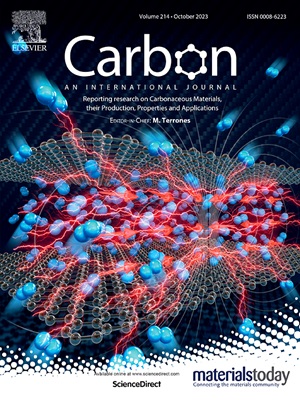Achieving high-performance flexible UV photodetectors: modulating oxygen vacancies via hydroxymethylated PEDOT and surface functionalities of N-doped graphene quantum dots
IF 10.5
2区 材料科学
Q1 CHEMISTRY, PHYSICAL
引用次数: 0
Abstract
This study presents a flexible UV photodetector with an organic-inorganic hybrid structure, fabricated using advanced face-to-face self-assembly. The detector is composed of PEDOT-CH2OH and nitrogen-doped graphene quantum dots (N-GQDs) modified zinc oxide nanoflowers (ZnO NFs). The sulfur and hydroxyl groups in PEDOT-CH2OH, along with nitrogen and oxygen functional groups in N-GQDs, promote the formation and stabilization of oxygen vacancies (Vo) on the ZnO NFs surface. This significantly enhances carrier separation efficiency, reduces electron-hole recombination, and improves the detector's performance. Under 365 nm UV light, the device achieves a response rate of 1.31 mA W−1 at 0V bias, with fast rise times (0.078 s) and fall time (0.093 s). The detector shows excellent stability and rapid photonic response, providing solid support for wearable electronics and new theoretical guidance for ZnO photodetector improvements.
实现高性能柔性紫外光电探测器:通过羟基化PEDOT和n掺杂石墨烯量子点的表面功能调制氧空位
本研究提出了一种柔性紫外光电探测器,具有有机-无机杂化结构,采用先进的面对面自组装制造。该探测器由PEDOT-CH2OH和氮掺杂石墨烯量子点(N-GQDs)修饰氧化锌纳米花(ZnO NFs)组成。PEDOT-CH2OH中的硫和羟基,以及N-GQDs中的氮和氧官能团,促进了ZnO NFs表面氧空位(Vo)的形成和稳定。这大大提高了载流子分离效率,减少了电子-空穴复合,提高了探测器的性能。在365 nm紫外光下,该器件在0V偏置下的响应速率为1.31 mA W−1,上升时间为0.078 s,下降时间为0.093 s。该探测器表现出优异的稳定性和快速的光子响应,为可穿戴电子技术提供了坚实的支持,并为ZnO光电探测器的改进提供了新的理论指导。
本文章由计算机程序翻译,如有差异,请以英文原文为准。
求助全文
约1分钟内获得全文
求助全文
来源期刊

Carbon
工程技术-材料科学:综合
CiteScore
20.80
自引率
7.30%
发文量
0
审稿时长
23 days
期刊介绍:
The journal Carbon is an international multidisciplinary forum for communicating scientific advances in the field of carbon materials. It reports new findings related to the formation, structure, properties, behaviors, and technological applications of carbons. Carbons are a broad class of ordered or disordered solid phases composed primarily of elemental carbon, including but not limited to carbon black, carbon fibers and filaments, carbon nanotubes, diamond and diamond-like carbon, fullerenes, glassy carbon, graphite, graphene, graphene-oxide, porous carbons, pyrolytic carbon, and other sp2 and non-sp2 hybridized carbon systems. Carbon is the companion title to the open access journal Carbon Trends. Relevant application areas for carbon materials include biology and medicine, catalysis, electronic, optoelectronic, spintronic, high-frequency, and photonic devices, energy storage and conversion systems, environmental applications and water treatment, smart materials and systems, and structural and thermal applications.
 求助内容:
求助内容: 应助结果提醒方式:
应助结果提醒方式:


